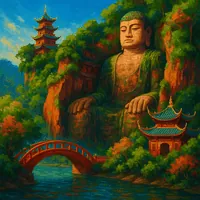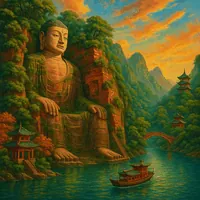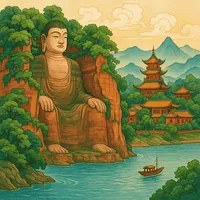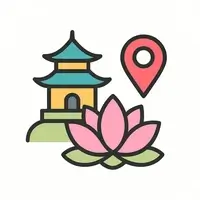


Leshan, China
Population: 3,160,168
Leshan, nestled at the confluence of the Min, Qingyi, and Dadu Rivers in Sichuan Province, is uniquely distinguished by the Leshan Giant Buddha, the world's tallest ancient statue of its kind, standing at 71 meters. Carved into a red sandstone cliff over 1,300 years ago, this UNESCO World Heritage Site symbolizes the harmonious blend of nature and spirituality. With serene vistas of Mount Emei nearby, Leshan offers a singular glimpse into ancient Chinese engineering marvels and Buddhist devotion.













Notable points about Leshan
- Leshan Giant Buddha: Leshan is home to the iconic Leshan Giant Buddha, the largest stone Buddha statue in the world, carved out of a cliff face in the 8th century. This UNESCO World Heritage Site stands at 71 meters and offers a unique and awe-inspiring experience for history enthusiasts and tourists alike.
- Confluence of Three Rivers: The city is uniquely situated at the confluence of the Min, Qingyi, and Dadu Rivers. This geographical trait not only shapes the scenic beauty of the area but also plays a significant role in the local culture and economy, attracting nature lovers and photographers year-round.
- Mount Emei Connection: As the gateway to Mount Emei, one of China's Four Sacred Buddhist Mountains, Leshan offers spiritual seekers and outdoor adventurers easy access to this sacred and biodiverse wonderland, which is also a UNESCO World Heritage Site.
- Distinctive Sichuan Cuisine: Leshan provides a delightful flavor journey for foodies, known for its spicy and rich Sichuan cuisine. Unique local delicacies, like Leshan tofu pudding and sweet-skinned duck, offer a distinct taste compared to other regional cuisines in China.
- Cultural Heritage and Festivals: Deeply rooted in tradition, Leshan celebrates various local festivals that highlight its rich cultural tapestry. These festivals offer an immersive experience into the customs and traditions unique to this region, unlike any other city in China.
- Charming Riverside Views: Ideal for couples seeking a romantic getaway, the picturesque riverside promenades offer serene walks with breathtaking views, particularly striking at sunset. The natural beauty makes it a perfect backdrop for memorable moments.
- Modernity Meets Tradition: Leshan uniquely combines modern infrastructure with traditional architecture. This juxtaposition makes it appealing for single urban dwellers who seek the conveniences of city life blended with cultural depth.
- Family-Friendly Activities: For families, Leshan offers a bounty of educational and fun activities, from exploring historical sites and museums to enjoying parks and gardens, providing a well-rounded experience for both children and adults.
- Hospitable and Warm Community: Leshan is known for its friendly and welcoming locals, which can be an attractive point for retirees looking for a peaceful, community-oriented place to settle down or visit.
- Unique Urban Planning: Unlike many sprawling Chinese metropolises, Leshan maintains a balance between urban planning and natural landscapes, making it distinct with its relatively low population density and focus on preserving natural beauty integrated within the urban environment.
Summarized Traveller Reviews
Leshan's Neighborhoods
Shizhong District
🎯 Key Attractions
- Leshan Giant Buddha Scenic Area: Home to the world-famous 71-meter stone Buddha carved into the cliffside.
- Dongpo Square: A lively gathering point with statues, fountains, and nightly street food stalls.
- Willow Lane Market: A narrow alley of vintage trinket shops and tea counters that feel untouched by time.
✨ Unique Aspects
Street-side mahjong games, riverside promenades, and the smell of fresh Sichuan pepper in the air—walk until your shoes remember the stones.
Emei Town
🎯 Key Attractions
- Mount Emei Scenic Area: One of China's Four Sacred Buddhist Mountains, dotted with temples and ancient trails.
- Baoguo Temple: The largest temple on Mount Emei, rich with carvings and chanting monks.
- Cloud Whisper Pavilion: A quiet hillside teahouse where locals insist the mist makes the tea sweeter.
✨ Unique Aspects
Morning market with wild mountain herbs, barefoot pilgrim paths, and bells that carry on the wind.
Giant Buddha Riverside
🎯 Key Attractions
- Lingyun Temple: A serene temple just above the Giant Buddha's head.
- Binhe Park: Lush riverside park perfect for evening strolls and kite flying.
- Fisherman's Wharf: A pier of small seafood grills where the river breeze cools the night air.
✨ Unique Aspects
Boat tours at dusk, golden light on water, and paths that feel like they’ve been walked for centuries.
Central Business District (CBD)
🎯 Key Attractions
- Leshan Financial Plaza: The city’s commercial hub with high-end offices and retail spaces.
- Star River Mall: A shopping center mixing global brands with local boutiques.
- Sky Memory Rooftop: A rooftop bar with a view of the Min and Dadu rivers meeting.
✨ Unique Aspects
Skyline views that glow like circuits at night, easy metro access, and a hum of opportunity in the air.
Wutongqiao
🎯 Key Attractions
- Wutongqiao Cultural Park: Converted factory space now home to galleries and design studios.
- Iron Bridge Walkway: An old railway bridge now pedestrianized for city views.
- River Echo Café: A loft-style café where the walls still smell faintly of machine oil.
✨ Unique Aspects
Weekend art markets, open-air concerts, and a sense of something just beginning.
Suji
🎯 Key Attractions
- Suji Riverside Path: A gentle path perfect for cycling at sunset.
- Harvest Market: A weekly farmers’ market with just-picked produce.
- Lantern Courtyard: A small square where paper lanterns sway at night like memories.
✨ Unique Aspects
Slow mornings, old brick walls, and a sky uncluttered by tall buildings.
Jinkouhe
🎯 Key Attractions
- Old Wharf Market: A gritty open-air market where fishermen sell the day’s catch.
- Steelworks Park: A reclaimed green space built on former industrial grounds.
- Blue Lantern Pier: An evening gathering place for riverside storytelling.
✨ Unique Aspects
Smell of the river mixed with hot oil from street grills, pockets of quiet away from the main roads.
Zhugongshan
🎯 Key Attractions
- Zhugongshan Temple: A hilltop temple with views over the city.
- Bamboo Trail: A shaded walking path through whispering groves.
- Spring House Teahouse: A home-turned-teahouse that claims to serve water from a mountain spring.
✨ Unique Aspects
Cooler air, bird calls in the morning, and the feeling of stepping out of time.
Jiajiang
🎯 Key Attractions
- Jiajiang Ancient Papermaking Workshop: Experience the traditional craft with centuries-old techniques.
- Thousand Buddha Cliff: Cliffside grottoes with hundreds of Buddha carvings.
- River Poets’ Corner: A quiet bend where local writers gather to read aloud.
✨ Unique Aspects
Gentle rhythm of village life, earthy smell of pulp and river water.
Miaoxia
🎯 Key Attractions
- Miaoxia Ferry Dock: A small ferry crossing that’s been in operation for decades.
- Stone Bridge Viewpoint: Rustic stone bridge perfect for watching sunsets.
- Grandmother’s Garden: A community-run flower garden open to visitors.
✨ Unique Aspects
Laundry lines swaying above cobbled lanes, the comfort of routines unchanged.
Shawan
🎯 Key Attractions
- Guo Moruo Memorial Hall: Museum dedicated to the famous writer and historian.
- Old Street of Shawan: Preserved Ming and Qing architecture with small craft shops.
- Poets’ Alley: A lane where verses are painted on the walls in fading ink.
✨ Unique Aspects
Lantern-lit nights, faint smell of ink, and the hush of history.
Erlang
🎯 Key Attractions
- Erlang Market Street: Packed with stalls selling everything from fresh chilies to woven baskets.
- Morning Tea Row: A string of tea houses where locals gather before work.
- The Red Balcony: An old wooden balcony now a favorite lookout for photographers.
✨ Unique Aspects
Early-morning steam from baozi baskets, chatter echoing off narrow walls.




































































































